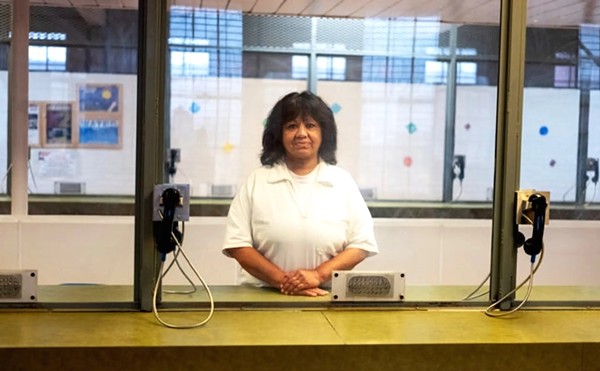“Let’s go crash this thing,” a kid tells his friend as he jumps into the driver seat of a car they just stole.
“I’m down,” the friend, now in the passenger seat, replies. “Where do you want to crash it?”
“Wherever.”
While joyriding, the criminal behind the wheel looks in the rear-view mirror and sees a car following closely behind him on the freeway.
“Please don’t be a cop,” the driver mutters to himself before becoming surprisingly religious. “Pray it’s not a cop. Pray, pray, pray, just pray.”
As the radio ironically plays the Smashing Pumpkins’ “Today” — this is definitely not going to be the greatest day they’ve ever known — the crime is being videotaped to help prosecute the suspects. You can check it out on Baitcar.com, a website archive of the most entertaining bait-car footage.
A bait car is one installed with a special system that informs police when it is being stolen. At the time of the crime, officers are able to track the stolen vehicle and arrest the car thieves.
Soon, the engine of the vehicle driven by the two teenagers is disabled by police (a feature on all bait-cars systems) and the felons dart out in a last-ditch effort to avoid jail time … spoiler warning: They’re caught.
The San Antonio Police Department currently has two bait-car systems “in the process of activation,” according to Michelle Kleiss, administrative assistant of the Vehicle Crimes Unit for SAPD. The City is hoping to build up its own Bait Vehicle Program, and our Regional Auto Crimes Team (ReACT, for short — made up of the SAPD, the Bexar County Sheriff’s Office, the National Insurance Crime Bureau, and the Texas Department of Public Safety) requested $260,000 from the Texas Automobile Theft Prevention Authority, a statewide money-doling agency. But on January 18, the Authority doled out only $132,000.
“We got about half of what we asked for,” said Kleiss, immediately adding that, money be damned, bait cars are still the City’s priority.
Driving Down Theft
Since the legislature authorized the ATPA in June 1991, Texas auto-theft rates decreased 42 percent over a 14-year-period. The Texas Department of Public Safety recorded more than 163,000 vehicles stolen statewide; by 2005, that number dropped below 94,000. Bexar County accounted for more than 6,500 thefts that year, making us Texas’s fourth worst place to park your car.
(The county had a very slight increase in auto thefts last year, with the majority of hot cars — some 1,600 — reported in the SAPD Westside substation’s area).
In 2006, more than $17 million was collected for ATPA through a $1-per-vehicle surcharge siphoned off auto insurance policies across the state. It was $2.25 million more than the budget projections, according to the Texas Comptroller’s office.
To some, this might seem like a lot of money to collect for car-theft prevention (our own vehicle theft team team, ReACT, was awarded a $3.1-million grant by the legislature for the fiscal year spanning September 1, 2006, through August 31, 2007). So why spend money on a social ill that seems to be gradually decreasing?
“Crime prevention is like preventive maintenance on your home,” says Michael Gilbert, UTSA associate professor of criminology. “If you don’t keep up with the maintenance of your home, it progressively deteriorates. If you don’t keep up effort to reduce crimes like car thefts it is likely to increase. In that sense, crime prevention is an investment comparable to insurance.”
Gilbert also says that although the decline in auto thefts could be linked to programs at the ATPA, other factors play a role.
“In large part, `the decrease` reflects demographic changes in our society where the age group most likely to be involved in street crime as teenagers and young adults represents a smaller proportion of our society than in the past,” Gilbert said. “However, this age group is likely to increase over the decade because there is a large pool of children in the age range of 5-15 who will progressively enter the at-risk age range of 15-24.”
Technological improvements in theft prevention could be a factor, too, which has lead to even more outlandish attempts by risk-taking thieves, Gilbert said.
“For professional thieves, there has been increasing use of tow trucks and even forklifts to pick cars up and quickly remove them from their location,” Gilbert said. And, he added, there’s still the old mainstay: carjacking.
| 4 Phrases ... On Car-Theft Know how when you’re abroad you can stay neutral in a tribal dispute near the world’s highest border crossing, the Khunjerab Pass, or impersonate Swami Beyondananda at a peace rally in Nairobi and all you need are a few useful phrases (like “I don’t get even, I get odder.” In Roman Urdu, “Mayn karnaa naheen haasil karna hamwaar, Mayn haasil karna ajeeb”)? Well here’re a composite number of lines you can use domestically. It’s 4 Phrases on: Car Theft. 1. The most desirable hot wheels across the nation in 2006 were small cars with powerful engines (among America’s top 10 stolen: the 2001 BMW M-Series Roadster and six Acura Integra* models). 2. You can judge a truck by its tranny shift quality (hmm … ) or you can judge it by how hard it’s coveted, but the 2006 data from two state authorities on Texas’s most stolen vehicle will only fuel the Ford vs. Chevy Civil War. The Texas Automobile Theft Prevention Authority says Chevy; the Department of Public Safety says Ford. Everyone agrees Dodge Pickups suck and are third. 3. High-brow tip for wrecking car thieves’ plans: Stencil your VIN onto car parts to discourage them from stripping and selling your ride piece by piece (SAPD offers free VIN etching; $29.99 DIY VIN-etching kits are available at Vinguard.org). Low-brow tip, courtesy Texas Automobile Theft Prevention Authority: Take your keys, dipstick. Nearly 20 percent of vehicles stolen were sitting as pretty, open, and willing as Paris Hilton. 4. To wreak a little late night revenge on your car thief (or bachelor-partying man) there’s HEAT!, aka Help End Auto Theft, a special auto decal giving police permission to stop that car anytime between 1 a.m. and 5 a.m. *Bonus: Chop shop tip o’ the day — Integra engines are easily swapped with Honda Accords’. Sources: CCC Information Services Inc. ATPA annual report. San Antonio Express-News. — Keli Dailey and Kiko Martinez Expect to hear more about bait cars and the scourge of car thieves this summer when the ATPA launches its $245,000 “We’re Sending a Signal” advertising campaign in San Antonio and Houston. |

















